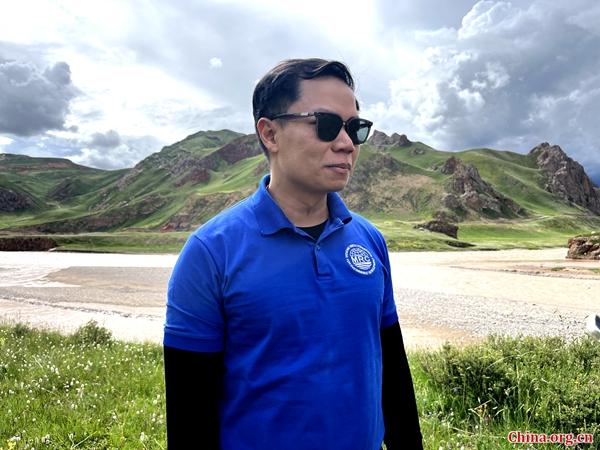
 0 Comment(s)
0 Comment(s) Print
Print E-mail China.org.cn, July 19, 2024
E-mail China.org.cn, July 19, 2024

Anoulak Kittikhoun, CEO of the Mekong River Commission (MRC) Secretariat, during an interview with China.org.cn, Qinghai province, July 17, 2024. [Photo by Xu Xiaoxuan/China.org.cn]
"We subscribe to the model of Lancang-Mekong cooperation. Shared river, shared future," said Anoulak Kittikhoun, CEO of the Mekong River Commission (MRC) Secretariat, in an exclusive interview with China.org.cn.
Speaking during the Joint Survey of the Lancang River Source by the six Lancang-Mekong countries, which commenced on July 15 in northwest China's Qinghai province, Kittikhoun highlighted the necessity for cooperation among the six countries of China, Cambodia, Laos, Myanmar, Thailand and Vietnam, as well as the importance of the joint survey.
"This historic trip marks the first time that the Lancang-Mekong Water Resources Cooperation Center and the MRC Secretariat have organized a joint survey of the river's source involving all six countries," Kittikhoun noted, adding that this collaboration fosters a deeper understanding of the upstream conditions of the Lancang-Mekong River.
Over the years, the Lancang-Mekong countries have been working closely to enhance understanding and collaboration in water resources management. A significant initiative in this effort has been the establishment and optimization of the Lancang-Mekong Water Resources Cooperation Information Sharing Platform. "The MRC stands ready to contribute to this platform, ensuring that all six countries benefit from data sharing," Kittikhoun stated.
Since 2002, the Chinese Ministry of Water Resources has regularly provided hydrological data to the MRC Secretariat during the flood season, extending to year-round information sharing since November 2020.
Kittikhoun also addressed the changing patterns of hydrological conditions in the Lancang-Mekong River Basin. "Phase 1 of the Joint Study on the Changing Patterns of Hydrological Conditions of the Lancang-Mekong River Basin and Adaptation Strategies concluded that climate change shows significant impact in the basin ," he said. "We must work together to address climate challenges as well as those regarding the development and management of water infrastructures."
Conducted by the Lancang-Mekong Water Resources Cooperation Center and the MRC Secretariat and completed in August 2023, the conclusion of the joint study was based on the analysis of long-term trends, frequency, duration, intensity, and role of El Nino, adding that meteorological factors play a dominant role in hydrological processes and changes.
"The ongoing joint survey aims to collect firsthand data to develop effective adaptation strategies to the basin's evolving hydrological conditions and to maximize the river's benefits for all countries involved," Kittikhoun said.

Lancang River, Qinghai province, July 16, 2024. [Photo by Xu Xiaoxuan/China.org.cn]
In addition, Kittikhoun lauded the Chinese government's efforts to protect the river's source, noting the increased focus on ecological and environmental factors in development projects. He remarked on the breathtaking scenery along the source of the Lancang River as a testament to China's conservation endeavors.
"The joint survey allows experts from all six countries to witness these efforts firsthand," Kittikhoun said. "This trip is the first of its kind, but it should not be the last." He revealed plans for a second joint survey of the downstream Lancang-Mekong River in September or October, inviting all six countries to gain more valuable insights.
Having visited China multiple times, Kittikhoun observed that hydropower projects in Yunnan province release water during droughts, benefiting Lancang-Mekong countries downstream. He also emphasized that the effective management of water resources can enhance energy and food security, and improve health by reducing waterborne diseases.
Reflecting on the shared history, culture and cuisine among the Lancang-Mekong countries, Kittikhoun expressed optimism for the future. He underscored the principle of "shared river, shared future," highlighting the importance of win-win cooperation in managing water resources among the six Lancang-Mekong countries.